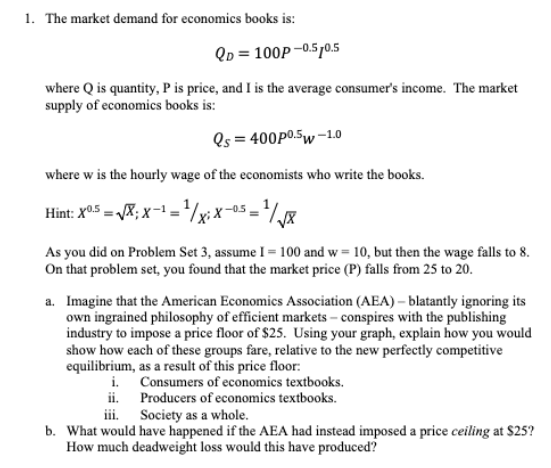1. The market demand for economics books is: QD = 100P –0.5/0.5 where Q is quantity, P is price, and I is the average consumer's income. The market supply of economics books is: Os = 400P0.5w-10 where w is the hourly wage of the economists who write the books. Hint: X05 = X; x -' =/xx-05 = / As you did on Problem Set 3, assume I = 100 and w= 10, but then the wage falls to 8. On that problem set, you found that the market price (P) falls from 25 to 20. a. Imagine that the American Economics Association (AEA) – blatantly ignoring its own ingrained philosophy of efficient markets – conspires with the publishing industry to impose a price floor of $25. Using your graph, explain how you would show how each of these groups fare, relative to the new perfectly competitive equilibrium, as a result of this price floor. i. Consumers of economics textbooks. ii. Producers of economics textbooks. iii. Society as a whole.
1. The market demand for economics books is: QD = 100P –0.5/0.5 where Q is quantity, P is price, and I is the average consumer's income. The market supply of economics books is: Os = 400P0.5w-10 where w is the hourly wage of the economists who write the books. Hint: X05 = X; x -' =/xx-05 = / As you did on Problem Set 3, assume I = 100 and w= 10, but then the wage falls to 8. On that problem set, you found that the market price (P) falls from 25 to 20. a. Imagine that the American Economics Association (AEA) – blatantly ignoring its own ingrained philosophy of efficient markets – conspires with the publishing industry to impose a price floor of $25. Using your graph, explain how you would show how each of these groups fare, relative to the new perfectly competitive equilibrium, as a result of this price floor. i. Consumers of economics textbooks. ii. Producers of economics textbooks. iii. Society as a whole.
Linear Algebra: A Modern Introduction
4th Edition
ISBN:9781285463247
Author:David Poole
Publisher:David Poole
Chapter2: Systems Of Linear Equations
Section2.4: Applications
Problem 27EQ
Related questions
Question
A6

Transcribed Image Text:1. The market demand for economics books is:
Qp = 100P –0.5p0.5
where Q is quantity, P is price, and I is the average consumer's income. The market
supply of economics books is:
Os = 400P0.5w -10
where w is the hourly wage of the economists who write the books.
Hint: X0.5 = X; x-
='½xix-os =
As you did on Problem Set 3, assume I = 100 and w = 10, but then the wage falls to 8.
On that problem set, you found that the market price (P) falls from 25 to 20.
a. Imagine that the American Economics Association (AEA) – blatantly ignoring its
own ingrained philosophy of efficient markets – conspires with the publishing
industry to impose a price floor of $25. Using your graph, explain how you would
show how each of these groups fare, relative to the new perfectly competitive
equilibrium, as a result of this price floor:
i. Consumers of economics textbooks.
ii. Producers of economics textbooks.
iii. Society as a whole.
b. What would have happened if the AEA had instead imposed a price ceiling at $25?
How much deadweight loss would this have produced?
Expert Solution
This question has been solved!
Explore an expertly crafted, step-by-step solution for a thorough understanding of key concepts.
This is a popular solution!
Trending now
This is a popular solution!
Step by step
Solved in 2 steps with 2 images

Recommended textbooks for you

Linear Algebra: A Modern Introduction
Algebra
ISBN:
9781285463247
Author:
David Poole
Publisher:
Cengage Learning

Algebra & Trigonometry with Analytic Geometry
Algebra
ISBN:
9781133382119
Author:
Swokowski
Publisher:
Cengage

Linear Algebra: A Modern Introduction
Algebra
ISBN:
9781285463247
Author:
David Poole
Publisher:
Cengage Learning

Algebra & Trigonometry with Analytic Geometry
Algebra
ISBN:
9781133382119
Author:
Swokowski
Publisher:
Cengage